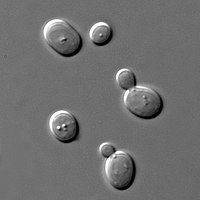
Photo from wikipedia
Background: Cannabis products are subjected to microbial testing for human pathogenic fungi and bacteria. These testing requirements often rely on non-specific colony forming unit (CFU/g) specifications without clarity on which… Click to show full abstract
Background: Cannabis products are subjected to microbial testing for human pathogenic fungi and bacteria. These testing requirements often rely on non-specific colony forming unit (CFU/g) specifications without clarity on which medium, selection or growth times are required. We performed whole genome sequencing to assess the specificity of colony forming units (CFU) derived from three different plating media: Potato Dextrose Agar (PDA), PDA with chloramphenicol and Dichloran Rose Bengal with chloramphenicol (DRBC). Methods: Colonies were isolated from each medium type and their whole genomes sequenced to identify the diversity of microbes present on each medium selection. Fungal Internal Transcribed Spacer (ITS3) and Bacterial 16S RNA(16S) quantitative polymerase chain reactions (qPCR) were performed, to correlate these CFUs with fungi- and bacterial- specific qPCR. Results: Each plating medium displayed a ten-fold difference in CFU counts. PDA with chloramphenicol showed the highest diversity and the highest concordance with whole genome sequencing. According to ITS3 and 16S qPCR confirmed with whole genome sequencing, DRBC under counted yeast and mold while PDA without chloramphenicol over counted CFUs due to bacterial growth without selection. Conclusions: Colony Forming Unit regulations lack specificity. Each medium produces significant differences in CFU counts. These are further dependent on subjective interpretation, failure to culture most microbes, and poor selection between bacteria and fungi. Given the most human pathogenic microbes found on cannabis are endophytes which culture fails to detect, molecular methods offer a solution to this long-standing quantification problem in the cannabis testing field.
Journal Title: F1000Research
Year Published: 2021
Link to full text (if available)
Share on Social Media: Sign Up to like & get
recommendations!